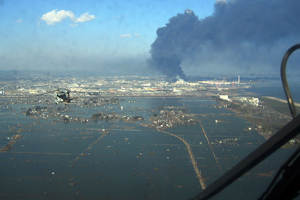
U.S. Navy
The port of Sendai after the tsunami, shot from a U.S. helicopter delivering food.
At 2:46 p.m. local time on March 11, 2011, the islands of Japan began to shake. As the world watched in shock, a 9.0-magnitude earthquake was followed by a devastating tsunami and then by radiation releases from nuclear power plants so damaged that they were unable to maintain the circulation of cooling water.
In the weeks following the earthquake, two geologists at Washington University in St. Louis — Doug Wiens, PhD, professor and chair of earth and planetary sciences in Arts & Sciences, and Michael Wysession, PhD, associate professor of earth and planetary sciences — were frequently interviewed by journalists seeking to understand a catastrophe that seemed at times beyond understanding.
The scientists sometimes offered calming perspective and at others they exposed unnerving truths about the power of tectonics and the depth of scientific ignorance about the earth and its dynamics.
“It’s important to remember that earthquakes are not a major cause of loss of life, certainly not in the U.S. and not anywhere,” says Wysessions. “If you take earthquakes in the U.S. going back 10, 20, 100 years, about nine people a year die. That puts it on par with skateboard accidents in terms of loss of life. Gobally maybe 30,000 or 40,000 people die a year, but to give you some perspective, cancer kills seven and a half million people a year.”
But just when his listeners are feeling reassured, he says, “There are a lot of faults around the world, and there are a lot of faults we don’t know about. If you look at a place like Southern California where the San Andreas fault run right along and takes a bend, that areas has had some very large earthquakes over the years: the Landers earthquake, the Big Bear, the Joshua Tree, the Northridge earthquake. Not one of them was on the San Andreas fault. Most of them in fact were on faults we didn’t know existed until they ruptured.”
Recently, if you emailed Doug Wiens, you got a bounceback message saying he was in Minnesota. Why Minnesota?
A partnership of more than 100 universities and government agencies is stepping an array of seismometers across the continental U.S. The array of some 400 high-quality seismographs, which started out on the west coast in 2007, has just reached the mid-continental strip extending south from Minnesota.
Minnesota isn’t exactly renowned for its seismic risk, but you’d be surprised. “A billion years ago, “says Wiens, “a big crack opened up in the continent there. It ran right down the middle of Lake Superior, through Minneapolis, into Iowa and ended up going over just west of Kansas City. “
“It shows up as a huge feature on gravity and magnetic anomaly maps,” Wiens says. “Everyone looks it and says, ‘what’s that?’ “
Here are short excerpts of their remarks about the Japanese quake.